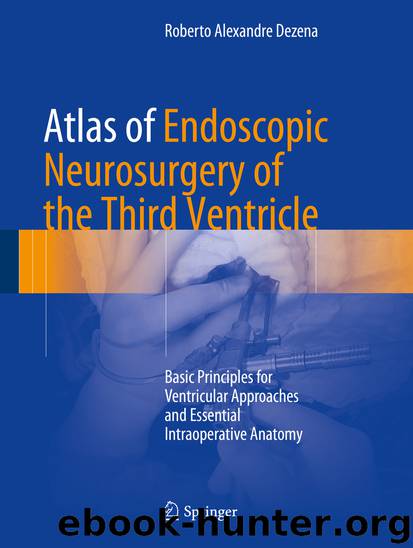Atlas of Endoscopic Neurosurgery of the Third Ventricle by Roberto Alexandre Dezena

Author:Roberto Alexandre Dezena
Language: eng
Format: epub
Publisher: Springer International Publishing, Cham
2.3.7 Biopsies and Tumor Resections
Intraventricular or paraventricular lesions touching the wall of the cavity have many differential diagnoses, and can be treated conservatively or by surgical resection, depending on the diagnosis. Thus, making the diagnosis is crucial. Performing a biopsy through a craniotomy can be disadvantageous, because it involves complex surgery and entails some risk in a condition that is sometimes clinically manageable. Against this background, stereotactic biopsy has emerged as an effective method for diagnosis. An endoscopic biopsy has the same benefits as the stereotactic technique, in addition to the advantage of being able to treat hydrocephalus by ETV, which is generally associated with these conditions. The biopsy is performed with biopsy forceps that pass through the working channel of the endoscope. As many fragments are necessary to make a diagnosis, is important to remove specimens both from the surface and from deeper parts of the lesion. If there is bleeding, this may be overcome by irrigation with warmed saline or by bipolar or monopolar coagulation. The positive results of endoscopic biopsies range from 82.8% to 94.7%. The complication rate is around 3.4–6.0% and mortality is 0–3.4% [118–120]. A recent systematic review and meta-analysis of a total of 2069 biopsies, which has added significantly to the current neuroendoscopic literature, shows that neuroendoscopic biopsies were performed concurrently with at least one other procedure in 82.7% of cases. The combined diagnostic yield in 28 studies reporting 1995 biopsies was 87.9%, the combined major morbidity from 17 studies reporting 592 biopsies was 3.1%, the combined mortality of 22 studies reporting 991 biopsies was 2.2%, and no significant differences were found in the diagnostic yield when comparing studies using rigid versus flexible endoscopes exclusively [121, 122]. With the progressive growth of endoscopic techniques, interest in intraventricular tumor resection through this less invasive method has emerged. Although there are no absolute conditions for the procedure to succeed, the ideal condition is for the injury to be poorly vascularized, have a soft consistency, be up to 2 cm in diameter, and have ventricular dilatation. A lesion that perfectly fits these conditions is the colloid cyst of the third ventricle. Several authors have reported excellent results, with lower morbidity, using the endoscopic resection technique, although the recurrence rate seems to be higher than that with microsurgery [123, 124]. The parallelism of the instruments makes handling them difficult. Their smaller diameter, and bleeding that clouds the view, requiring frequent irrigation, still make the endoscopic resection technique very limited. Currently, there is already an endoscope model that allows the use of an ultrasonic aspirator inside it, increasing the efficiency of the resection [125]. It is possible that the development of new instruments may increase the potential of this technique in the resection of intraepithelial and paraventricular lesions.
Download
This site does not store any files on its server. We only index and link to content provided by other sites. Please contact the content providers to delete copyright contents if any and email us, we'll remove relevant links or contents immediately.
The Art of Coaching by Elena Aguilar(52211)
Thinking, Fast and Slow by Kahneman Daniel(11806)
The Art of Thinking Clearly by Rolf Dobelli(9930)
The 5 Love Languages: The Secret to Love That Lasts by Gary Chapman(9295)
Mindhunter: Inside the FBI's Elite Serial Crime Unit by John E. Douglas & Mark Olshaker(8724)
When Breath Becomes Air by Paul Kalanithi(8045)
Periodization Training for Sports by Tudor Bompa(7930)
Becoming Supernatural by Dr. Joe Dispenza(7847)
Turbulence by E. J. Noyes(7717)
Bodyweight Strength Training by Jay Cardiello(7681)
Therapeutic Modalities for Musculoskeletal Injuries, 4E by Craig R. Denegar & Ethan Saliba & Susan Saliba(7601)
The Road Less Traveled by M. Scott Peck(7284)
Nudge - Improving Decisions about Health, Wealth, and Happiness by Thaler Sunstein(7261)
Mastermind: How to Think Like Sherlock Holmes by Maria Konnikova(6944)
Enlightenment Now: The Case for Reason, Science, Humanism, and Progress by Steven Pinker(6879)
Win Bigly by Scott Adams(6833)
Kaplan MCAT General Chemistry Review by Kaplan(6605)
Why We Sleep: Unlocking the Power of Sleep and Dreams by Matthew Walker(6367)
The Way of Zen by Alan W. Watts(6292)
